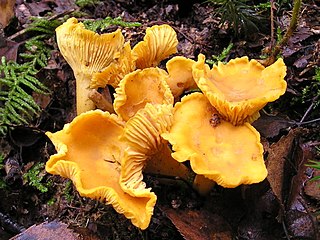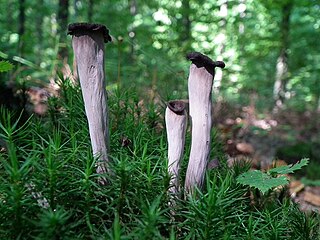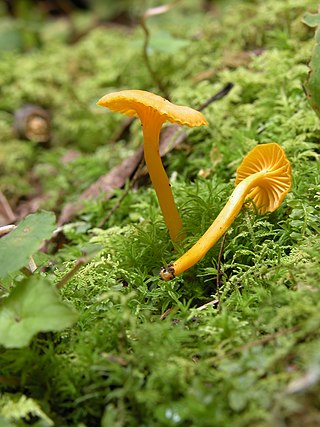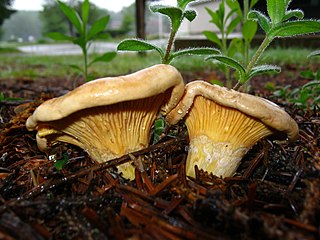
Chanterelle is the common name of several species of fungi in the genera Cantharellus, Craterellus, Gomphus, and Polyozellus. They are among the most popular of wild edible mushrooms. They are orange, yellow or white, meaty and funnel-shaped. On the lower surface, underneath the smooth cap, most species have rounded, forked folds that run almost all the way down the stipe, which tapers down seamlessly from the cap. Many species emit a fruity aroma, reminiscent of apricots, and often have a mildly peppery taste. The name chanterelle originates from the Greek kantharos meaning "tankard" or "cup", a reference to their general shape.

Cantharellus is a genus of mushrooms, commonly known as chanterelles, a name which can also refer to the type species, Cantharellus cibarius. They are mycorrhizal fungi, meaning they form symbiotic associations with plants. Chanterelles may resemble a number of other species, some of which are poisonous.

Cantharellus cibarius is a species of golden chanterelle mushroom in the genus Cantharellus. It is also known as girolle. Despite its characteristic features, it may resemble at least one poisonous species.

Craterellus is a genus of generally edible fungi similar to the closely related chanterelles, with some new species recently moved from the latter to the former. Both groups lack true gills on the underside of their caps, though they often have gill-like wrinkles and ridges.

Craterellus cornucopioides, or horn of plenty, is an edible mushroom. It is also known as the black chanterelle, black trumpet, trompette de la mort (French), or trumpet of the dead, djondjon (Haitian).

Hygrophoropsis aurantiaca, commonly known as the false chanterelle, is a species of fungus in the family Hygrophoropsidaceae. It is found across several continents, growing in woodland and heathland, and sometimes on woodchips used in gardening and landscaping. Fruit bodies (mushrooms) are yellow–orange, with a funnel-shaped cap up to 8 cm across that has a felt-like surface. The thin, often forked gills on the underside of the cap run partway down the length of the otherwise smooth stipe. Reports on the mushroom's edibility vary – it is considered poisonous, but has historically been eaten in parts of Europe and the Americas.

Craterellus tubaeformis is an edible fungus, also known as yellowfoot, winter mushroom, or funnel chanterelle. It is mycorrhizal, forming symbiotic associations with plants, making it very challenging to cultivate. It is smaller than the golden chanterelle and has a dark brown cap with paler gills and a hollow yellow stem. C. tubaeformis tastes stronger but less fruity than the golden chanterelle. It has a very distinctive smokey, peppery taste when raw. It grows in temperate and cold parts of Northern America and Europe, including Scandinavia, Finland, Russia, and the British Isles, as well as in the Himalayas in Asia, including Assam, in the central parts of the Indian subcontinent, and in Thailand.

Craterellus lutescens, formerly sometimes called Cantharellus lutescens or Cantharellus xanthopus or Cantharellus aurora, commonly known as Yellow Foot, is a species of mushroom. It is closely related to Craterellus tubaeformis. Its hymenium is usually orange or white, whereas the hymenium of C. tubaeformis is grey. C. lutescens is also usually found in wetlands.

Gomphus clavatus, commonly known as pig's ears or the violet chanterelle, is an edible species of fungus in the genus Gomphus native to Eurasia and North America. The fruit body is vase- or fan-shaped with wavy edges to its rim, and grows up to 15–16 cm wide and 17 cm tall. The upper surface or cap is orangish-brown to lilac, while the lower spore-bearing surface, the hymenium, is covered in wrinkles and ridges rather than gills or pores, and is a distinctive purple color. Described by Jacob Christian Schäffer in 1774, G. clavatus has had several name changes and many alternative scientific names, having been classified in the genus Cantharellus, though it is not closely related to them.

Polyozellus is a fungal genus in the family Thelephoraceae, a grouping of mushrooms known collectively as the leathery earthfans. Previously considered a monotypic genus, it now contains the Polyozellus multiplex species complex. The genus name is derived from the Greek poly meaning many, and oz, meaning branch. It is commonly known as the blue chanterelle, the clustered blue chanterelle, or, in Alaska, the black chanterelle. The distinctive fruit body of this species comprises blue- to purple-colored clusters of vase- or spoon-shaped caps with veiny wrinkles on the undersurface that run down the length of the stem.

Polyozellus multiplex is a species complex of fungi first described in 1899. P. multiplex is commonly known as the blue chanterelle, the purple chanterelle, or, in Alaska, the black chanterelle. However, this mushroom is not closely related to true chanterelles. While this name used to refer to a group of species, it is now used to describe only one species that held onto the name P. multiplex. The fruiting bodies of this species are blue- to purple-colored clusters of vase- or spoon-shaped caps, with veiny wrinkles on the underside which run down the length of the stem. P. multiplex was considered the monotypic species of the genus Polyozellus until recent molecular research divided the P. multiplex species complex into five species. The genus name is derived from the Greek poly meaning many, and oz, meaning branch. The specific epithet multiplex means "in many pieces," referring to the compound nature of the fruiting body.

Cantharellus lateritius, commonly known as the smooth chanterelle, is a species of edible fungus in the mushroom family Cantharellaceae. An ectomycorrhizal species, it is found in Asia, Africa, and North America. The species has a complex taxonomic history, and has undergone several name changes since its first description by American mycologist Lewis David de Schweinitz in 1822. The fruit bodies of the fungus are brightly colored yellow to orange, and usually highly conspicuous against the soil in which they are found. At maturity, the mushroom resembles a filled funnel with the spore-bearing surface along the sloping outer sides. The texture of the fertile undersurface (hymenium) of the caps is a distinguishing characteristic of the species: unlike the well-known golden chanterelle, the hymenium of C. lateritius is much smoother. Chemical analysis has revealed the presence of several carotenoid compounds in the fruit bodies.

Cantharellus formosus, commonly known as the Pacific golden chanterelle, is a fungus native to the Pacific Northwest region of North America. It is a member of the genus Cantharellus along with other popular edible chanterelles. It was distinguished from the similar C. cibarius of Europe in the 1990s. It is orange to yellow, meaty and funnel-shaped. On the underside of the smooth cap, it has gill-like ridges that run down onto its stipe, which tapers down seamlessly from the cap. The false gills often have a pinkish hue. It has a mild, sweet odor. It is solitary to gregarious in coniferous forests, fruiting from July to December.

Cantharellus subalbidus, the white chanterelle, is a fungus native to California and the Pacific Northwest region of North America. It is a member of the genus Cantharellus along with other popular edible chanterelles. It is similar in appearance to other chanterelles except for its cream to white color and orange bruising.

Cantharellus californicus, also called the California golden chanterelle, mud puppy, or oak chanterelle, is a fungus native to California, United States. It is a member of the genus Cantharellus along with other popular edible chanterelles. It is generally similar in appearance to C. cibarius and C. formosus except for its large size at maturity; individual specimens larger than 1 kilogram (2.2 lb), or greater, are reported, making it the largest known species of chanterelle. Their unusual size is due in part to their capacity for indeterminate growth, making Cantharellus californicus specimens actively grow for far longer than most other mushrooms. It will become the official state mushroom of California in 2024.

Cantharellus cascadensis, the Cascade chanterelle, is a fungus native to the Pacific Northwest region of North America. It is a member of the genus Cantharellus along with other popular edible chanterelles. It is named after the Cascade Range, where it was formally described in 2003. It is considered a choice edible mushroom.

Cantharellus minor is a fungus native to eastern North America. It is one of the smallest of the genus Cantharellus, which includes other edible chanterelles. It is suspected of being mycorrhizal, found in association with oaks and moss. Recently, C. minor has been reported from semi-evergreen to evergreen forests in the Western Ghats, Kerala, India forming ectomycorrhizal associations with tree species like Vateria indica, Diospyros malabarica, Hopea parviflora, and Myristica species. The cap of C. minor ranges from 0.5 to 3.0 cm wide and is convex and umbonate, often shallowly depressed, becoming funnel-shaped in some. The yellowish gills are decurrent, and fade to yellowish white in maturity. The stipe is less than 4 cm (1.6 in) tall. They fruit in the summer and fall. Although insubstantial, they are edible.

Cantharellus persicinus, the peach or pink chanterelle, is a fungus native to the Appalachian region of eastern North America. Like other popular edible chanterelles, it is a member of the genus Cantharellus. It is suspected of being mycorrhizal, found in association with oaks and eastern hemlock.

Hygrocybe cantharellus, commonly known as chanterelle waxy cap, is an agaric in the family Hygrophoraceae. It is found in eastern North America and Australia. The European Hygrocybe lepida was previously referred to this name, but is now known to be distinct.

Cantharellus enelensis is one of several species of chanterelle native to North America. It is a new member of the C. cibarius complex and wasn't discovered until 2017. Chanterelles identified with DNA sequencing as C. enelensis have been found in Newfoundland, Quebec, Michigan and Illinois but there is evidence to suggest it is widespread in North American conifer forests. It has been temporarily categorized as having a conservation status of 'least concern'. Members of the C. cibarius complex in eastern North America are difficult to distinguish from one another without special techniques such as DNA sequencing and microscopic examinations. C. enelensis is the most commonly found chanterelle in Newfoundland. C. enelensis is one of 40 varieties of Cantharellus that grows in North America.



















